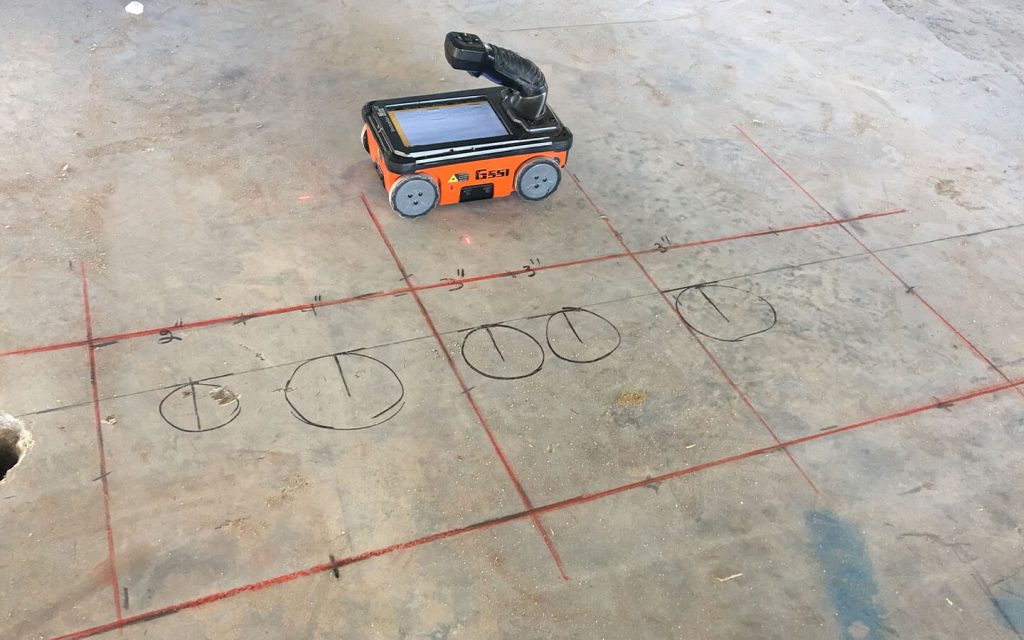Discovering the Trick Benefits of Concrete Scanning in Building And Construction Projects
In the world of contemporary building practices, the utilization of concrete scanning technology has emerged as a pivotal device for making sure task effectiveness and architectural stability. From enhancing safety and security actions to accurately discovering utilities hidden beneath the surface, the benefits of concrete scanning are multifaceted. RainierGPR Concrete Scanning.
Improved Safety Steps
Making use of advanced concrete scanning innovation boosts safety procedures on building and construction sites by offering exact detection of prospective threats hidden underneath the surface area. This technology allows building and construction groups to identify rebar, channels, post-tension cables, and various other blockages prior to excavation or drilling, significantly minimizing the threat of crashes. By identifying these elements precisely, employees can avoid harmful critical structural parts, hence stopping injuries, delays, and costly repairs.
Moreover, concrete scanning plays a vital duty in making certain the honesty of existing structures during renovations or developments. By detecting weak points, spaces, or degeneration within concrete components, engineers can attend to these concerns proactively, boosting the total security and durability of the building. This positive technique not only mitigates the threat of structural failures however likewise decreases the potential for accidents triggered by unpredicted structural deficiencies.
Fundamentally, the application of concrete scanning technology works as a proactive precaution that safeguards both building and construction workers and the architectural stability of structures, ultimately adding to the overall success and effectiveness of construction jobs. - RainierGPR Concrete Scanning
Accurate Discovery of Utilities
Concrete scanning modern technology promotes accurate recognition of below ground utilities, boosting building and construction website security and effectiveness. Precise detection of energies is critical in construction projects to avoid costly damages, project delays, and most notably, make sure the safety of employees and the public. By utilizing innovative scanning innovations such as ground-penetrating radar (GPR) and electro-magnetic induction, construction groups can map out the location of buried pipelines, cables, and various other energies with high levels of accuracy.
Time and Price Efficiency

Concrete scanning technology enables building and construction groups to precisely find rebar, post-tension cable televisions, and various other ingrained objects within concrete structures. This precise information aids in preventing costly mistakes such as unexpected damages to vital elements during exploration, reducing, or coring activities. Furthermore, by recognizing possible risks ahead of time, the need for costly fixings or revamp due to problems can be minimized, resulting in set you back savings for the project.

Furthermore, the capacity to quickly and properly spot energies beneath the surface area without creating any kind of damage not just saves time yet also stops pricey disturbances to existing infrastructure. Generally, the moment and cost efficiency advantages of concrete scanning make it an important device for improving building job administration and execution.
Preservation of Structural Integrity
Preserving the architectural honesty Homepage of structures and facilities is extremely important in making certain lasting security and security. Concrete scanning plays a crucial role in this preservation process by permitting building and construction specialists to identify potential risks to the structural stability of a building or facilities prior to they rise into major concerns. Through using advanced scanning technologies such as ground-penetrating radar (GPR) and electromagnetic induction, building and construction groups can non-invasively assess the condition of concrete frameworks, find rebar, post-tension cables, and other read more ingrained elements, and recognize any gaps, splits, or damage within the concrete.
Improved Job Planning
In order to make sure the successful implementation of building jobs, careful interest to detail and comprehensive planning are necessary components that stem from a thorough understanding of the architectural conditions identified with concrete scanning. Improved task planning, facilitated by concrete scanning, enables building and construction teams to preemptively address prospective challenges, assign sources a lot more efficiently, and develop sensible timelines. By accurately recognizing the place of rebar, post-tension cables, and various other embedded items within concrete frameworks, project supervisors can develop extra specific construction strategies that minimize the risk of expensive mistakes or delays. Furthermore, the information obtained from concrete scanning allows stakeholders to make educated choices regarding architectural alterations, remodellings, or developments, resulting in smoother task transitions and boosted overall task outcomes. Inevitably, including concrete scanning into the task planning phase boosts control amongst staff member, cultivates aggressive analytical, and contributes to the effective delivery of building and construction jobs within budget plan and timetable restrictions.
Conclusion
Finally, concrete scanning offers many advantages in building jobs. By improving precaution, properly identifying utilities, improving time and expense performance, preserving structural honesty, and assisting in job planning, concrete scanning proves to be a crucial tool for effective job implementation. Its capacity to mitigate risks, increase efficiency, and make certain project honesty makes it a vital possession for building experts.
In the realm of modern-day building and construction methods, the usage of concrete scanning technology has emerged as a critical tool for making sure job effectiveness and architectural honesty.Concrete scanning modern technology allows building and construction teams to accurately locate rebar, post-tension cords, and other ingrained things within concrete structures. Through the usage of innovative scanning innovations such as ground-penetrating radar (GPR) and electro-magnetic induction, construction groups can non-invasively analyze the condition of concrete frameworks, situate rebar, post-tension wires, and other ingrained components, and identify any type of gaps, cracks, or degeneration within the concrete.
In order to make certain the successful execution of building and construction projects, precise focus to information and complete preparation are vital parts that stem from a comprehensive understanding of the structural conditions determined via concrete scanning. Ultimately, incorporating concrete scanning into the task planning phase boosts coordination amongst team members, fosters proactive analytic, and contributes to the effective shipment of building jobs within budget and schedule constraints.